https://www.youtube.com/watch?v=6Etx8WtPIMI
How to Draw a Face Accurately - Exercises to Improve Your Drawing
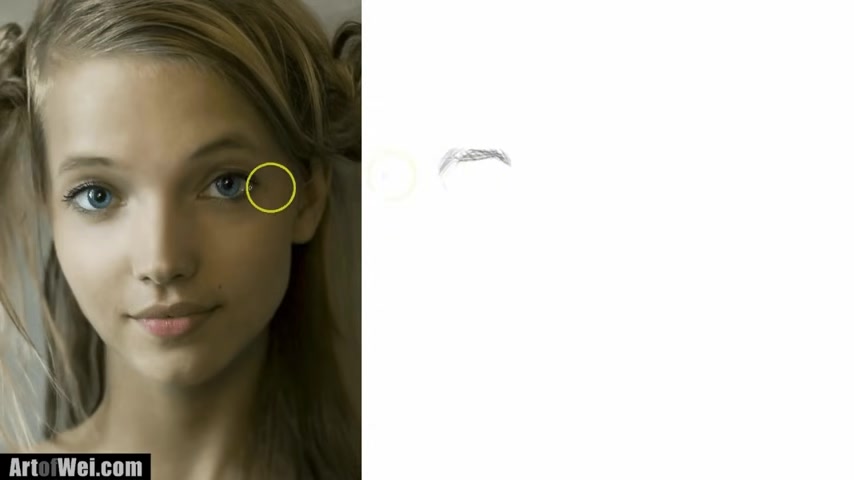
Hey , everyone .
This is way .
Thanks for checking this video out and uh let me show you how to draw a pretty face and still have it look pretty .
Uh in other words , how to draw accurately .
So let me get started and I will talk about the process along the way .
All right .
So let's draw this face .
Um Let's see .
I'm just gonna start on the left side again because I'm right handed .
Now I'm just going to start right on her eye and I'm gonna do um her eyebrow first just so because at the beginning , you need some kind of reference point .
So I'm just going to start with that and you can keep the , just look at the eyebrow , just keep in line of the slant , right ?
So there's a certain slant to this .
So that's how I got this eyebrow started and then curves down and then now we're going to go straight down to your eye .
We can go , let's say this is the corner , corner to corner , it's that angle , right ?
So it's that and then now we have the corner of your eye .
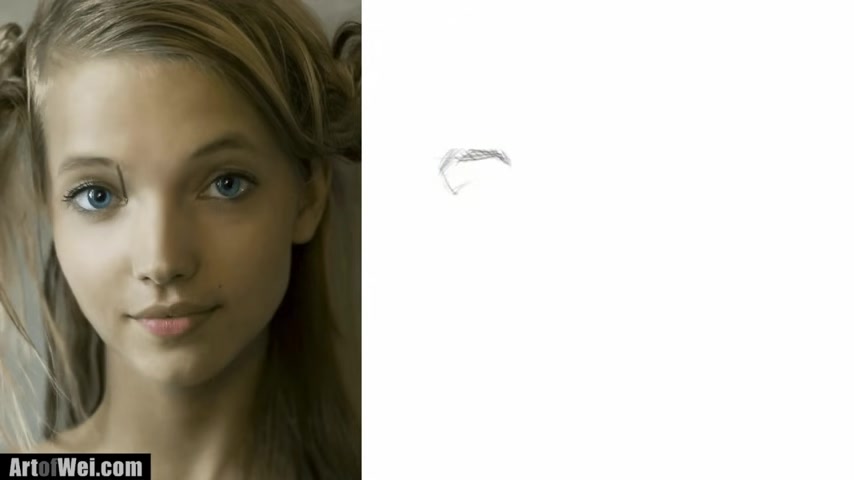
So I'm gonna start doing , let's see other other corner of your eye , you can tell , tell us like that angle .
So maybe somewhere around here that's the corner and then you can also check it like if you draw a line like this um slightly down , it's almost horizontal from the screen .
So it's gonna be probably something close to this .
Then that's I fill up corner corner and I fall .
So , so now we have something to go on , right ?
It's going to be slightly larger than the reference picture .
So now we have our eye .
So now we can do , let's say the just make a mark on the corner of face like how far is this ?
And , and if you compare it , it's kind of like the width for I the white area .
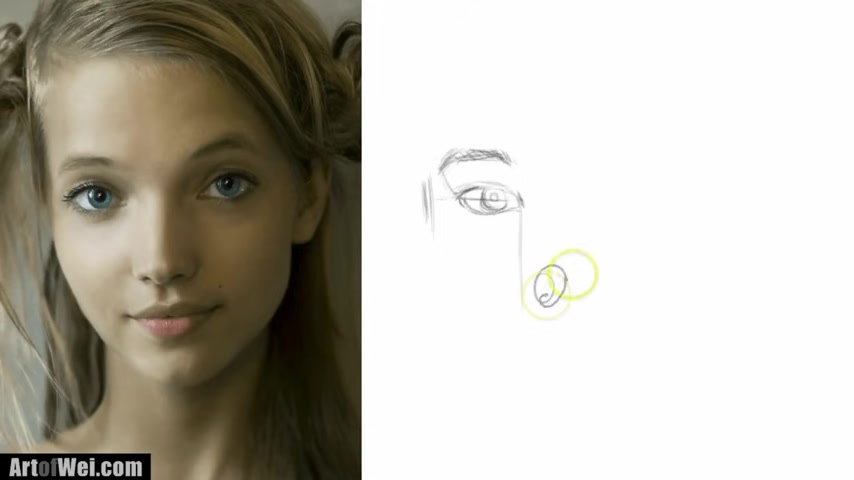
So it's probably gonna be somewhere here , somewhere around there .
So , but let's get the other features too because it's a little bit more important than the than the face .
We can always fill that in later .
Now , from the , where's the no star , right ?
If you , and if you look at it from a corner , you go straight down , it's kind of slightly to the right of it .
So if I make a mark straight down here , now we know the nose is gonna be somewhere right here but where , right .
So we can try triangulate it .
Um If you take the corner here and we scroll like this , that is your angle .
So we need to replicate that angle and I'm gonna push it right around .
Let's something around , let's see it there , there probably somewhere around here because that's gonna be the angle .
So now we know , you know , this is gonna be the corner right here and now we have this .
Ok .
So now we have the corner .
Now , how wide is this nose , uh her nose ?
And if you look at it , it's probably the width of her eye .
It's probably the same whiff .
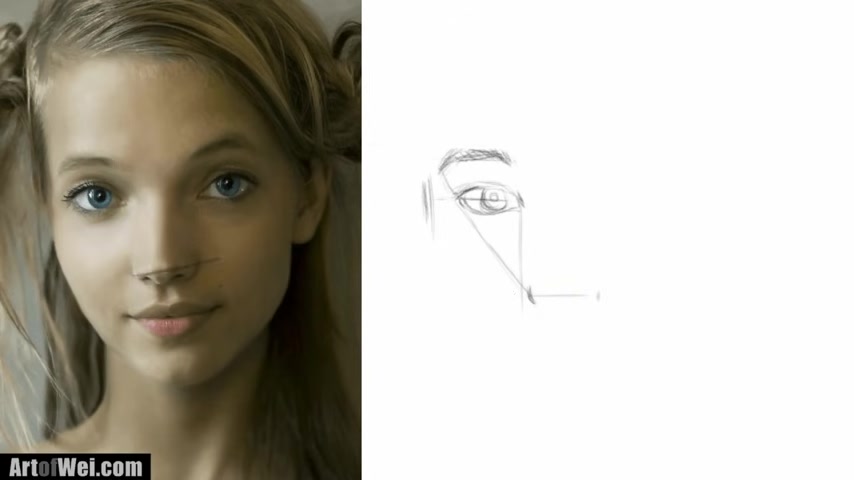
So I'm gonna do the whiff her eyes probably somewhere around here .
So now we have the whiff of her nose .
Now , keep in mind there's still a slant here because of the , the whole reference is slightly slanted , it's just slanting this way .
So just to give us , uh , so that we don't draw , you know , a straight nose .
Ok .
So then we from the middle here , then we could just fill in the , uh , because once you have this two points here , now you can just fill in the rest .
It's now that we have those two reference points .
So now we ever knows .
And then let's go straight down to your mouth .
Now , how far is your mouth ?
Uh , let's see , from here to here , it's probably from this distance to this distance .
So from here to here it's the same distance .
So as far as somewhere right here , this is gonna be your upper lip and then we can draw this little triangle right here , which is probably around here , the middle and the lip .
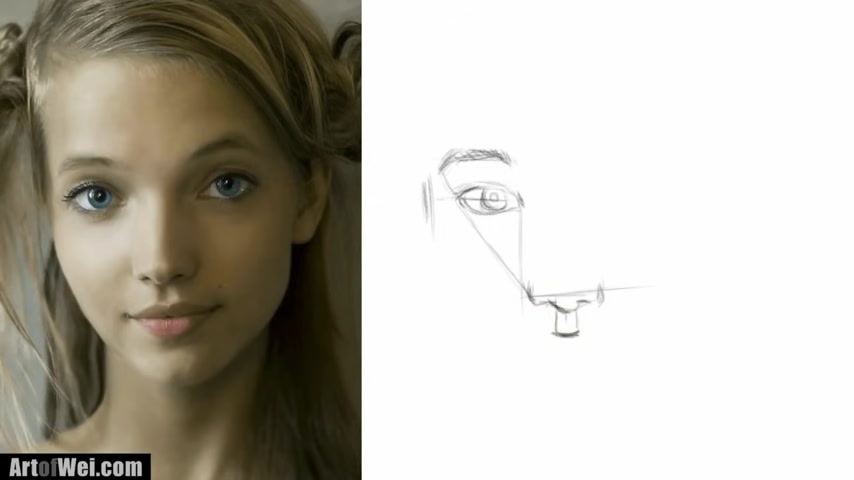
Now , um corner of her mouth , where is the corner of her mouth ?
And this one is slightly easier because if you go straight down from my eye , it's pretty close to vertical .
So we again , we gotta go straight down , we gonna continue this line and this is gonna be the corner of her mouth somewhere , ok ?
So we need to find this angle right ?
So we just kind of eyeball that fire somewhere right here .
So this this , OK .
Now we have a corner of our mouth now to find the other corner .
Um Just keep in mind the slant here , but there's a slight curvature and slants upper a little bit and we need to replicate that .
So its lands upward and then let's see how far , how far is this and we can take this angle if you like from the , from her nose and we can replicate that angle and that'll give us approximately right here and we got food her lips , upper lip and then her lower lip .
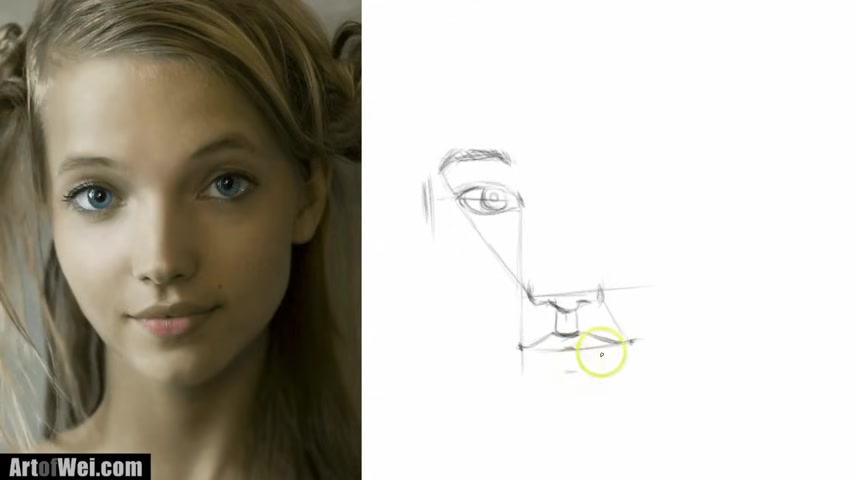
Um obviously , if you measure this , it is slightly bigger than her upper lip , which is pretty normal .
So now we're at this point and then we can just fill in the rest .
Ok .
So now let's uh let's move back up and do the other eye .
Ok .
Let's find uh how do we find this ?
Right ?
So from this corner , you can see that slant right there .
So we need to replicate the same slant , which is probably the same as our lip too .
So we're gonna slant this way .
And now how far do we go out ?
Now if we measure it probably reaches ?
Right ?
No , if you go down vertical .
So in general , that's how you measure it by seeing , you know , relationships like what is vertical and what is horizontal to each other like this point meets up at this point .
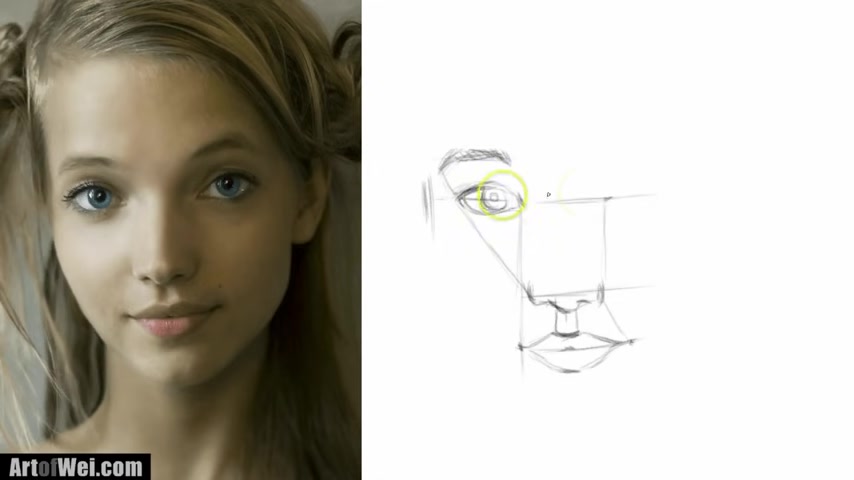
Um And , and that's how you , you know , find those , those reference points .
So now that we at the corner of the eye here , we can measure you see the whiff of her eye is pretty much the same as her other eye .
Now , keep in mind there's a slant upward too , so it's gonna go up this way .
So if you measure this width to this width , it's probably be somewhere right there and it takes , it takes a little bit of practice um to be able to , you know , see a distance and put it somewhere else , but you know , the more you do it , uh obviously the the better you can get at it .
OK ?
And then I see you up and how big is this eye looks pretty similar to her other eye .
So we can actually do a little guideline like this and go straight up this way and now give us a some reference points to , to work with .
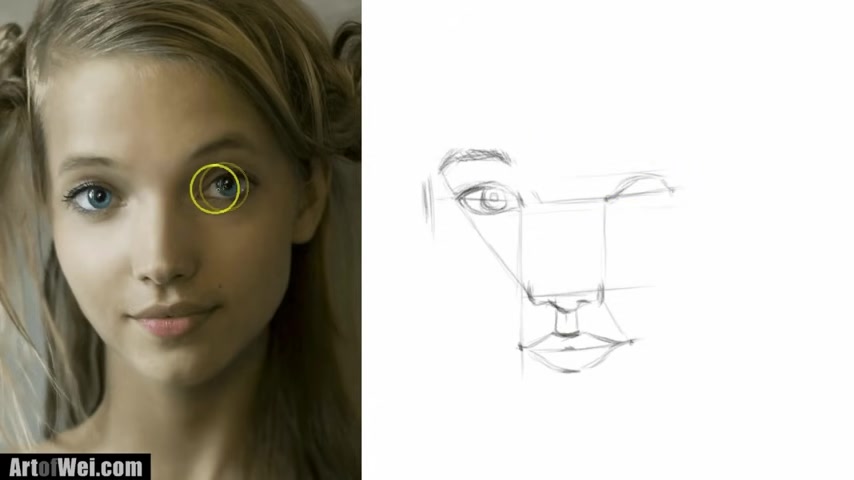
So I now notice this angle right here and that's what I'm replicating right here , here , here , let's see .
And then it goes down , but this way , it always kind of slits upper a little bit .
We got the little line there , your eyeball and the Irish people .
OK .
Now , the uh the eyebrow , we can , we can measure this angle again , it's pretty much the same .
And this one and then from here to here , that's where it starts right from the corner of the eyes .
And now at this point here , and we got to keep in mind this slant right here .
So we're going to do that slant .
Ok .
Excellent .
And then how do we find this breaking point ?
When does it start breaking ?
We just , we go look straight down , it's gonna be right around , you know , this area , right ?
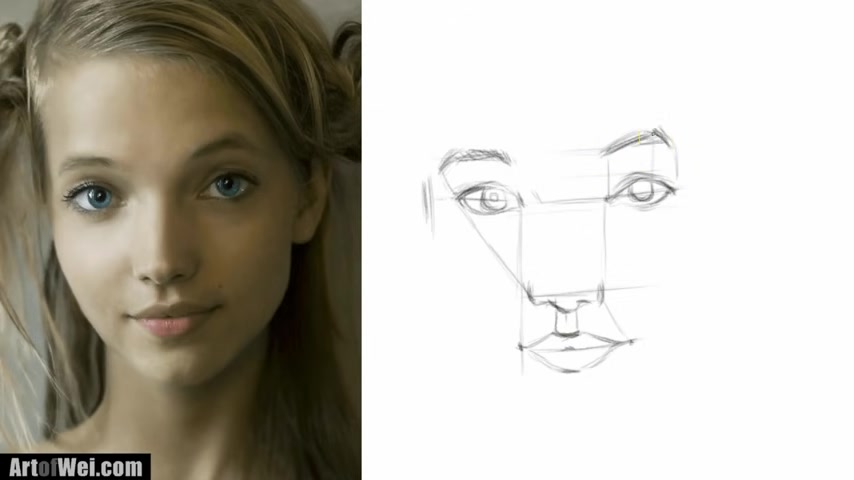
I uh and in the corner like that , this angle and it looks like I need to make her , I think this eye is a little bit too slow , but let's just go with it and uh see what happens , try a little bit higher .
OK .
So now we have this , let's just finish off the rest of our face .
Let's see , going back to this corner .
Now , how far is this point right here ?
And you can measure from here to here .
It's pretty similar , right ?
So you can get that angle like this , you probably bring us the , the side of her face .
And then now we can just connect this to a little bump do .
Now her chin , how far is her chin ?
Um down ?
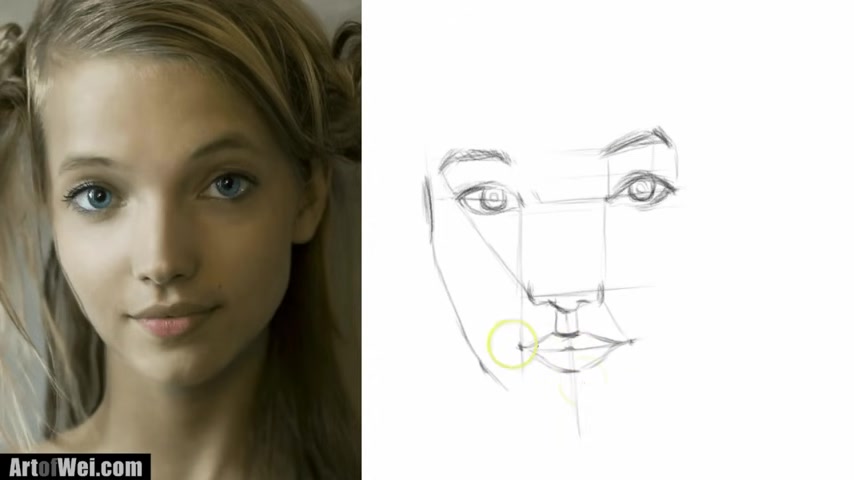
Now keep in mind this angle too , because this is , this is a slight tilt on the face .
So let's let's make a mark there .
Now , this distance looks like it's pretty close to , you know , from the bottom of her nose .
So we do that and then we go , we duplicate double that distance .
We probably somewhere right here .
So now we have this and now we can just fill in the rest , this curvature right here .
It's right under mouth scarves .
OK .
And let's get to the other side of the face .
Let see , let's get this point here to hear .
This distance is pretty close to your eye , right , the whiff of her eye .
So we double the whiff of her .
I probably give us somewhere right there so we can do that .
Now , we have this point go straight down kind of like this like curvature .
Now , where's the breaking point ?
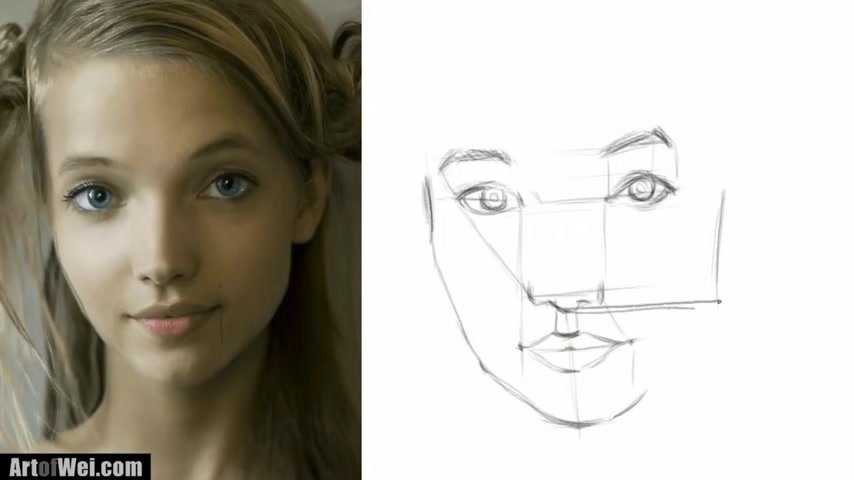
Let's find the breaking point .
Uh If we go horizontally , it's right around her nose .
So if we go horizontally here , it's gonna be somewhere around right here .
So this is where it starts curving and that goes down and we can connect that in her ear .
It's just right above her nose a little bit .
So probably somewhere right here .
And then the top of here where here is , is kind of right there .
So it's gonna be right around there so we can come down now and let's see here and let's do the hair a little bit .
Uh I mean , a forehead now to measure the forehead , it's a little bit harder because there's not a lot of reference points .
But if you go straight up , see how far is this distance .
It's probably , if you double it , it'll probably be somewhere right here .
So we can measure from here to here and then we double it .
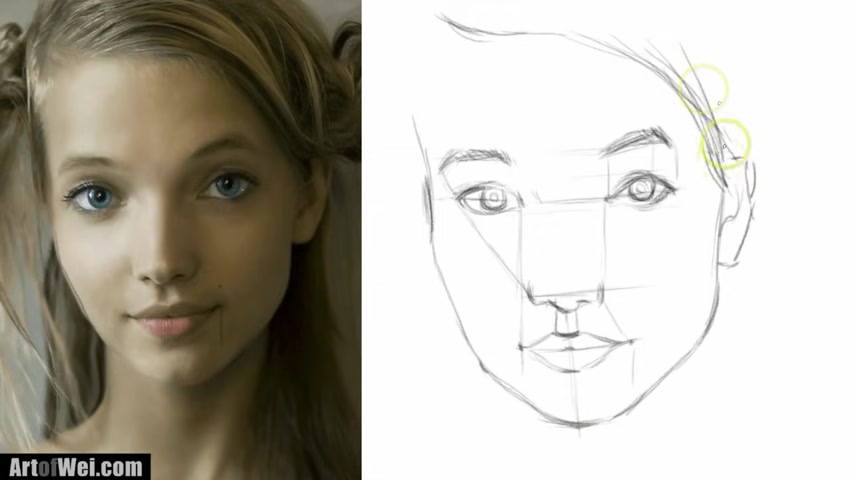
It'll probably be somewhere right here .
And it's like right here , it starts curving , you can look down , it's right around the eyebrow right here .
So now we know this curves right here , got straight down and you know , this part you can see just kind of goes in , goes down .
I think we can just kind of eyeball that , I mean , you can , you can measure , you know , maybe from this distance to this distance .
How far is that and things like that .
Um But if some of them are a little bit more obvious , so you can just quickly eyeball it in then a hair here here , here here .
OK .
So let's do her neck .
Where's her neck ?
It goes straight up , it's right on the eye straight up .
What's her neck ?
And then this right here right here , right around here .
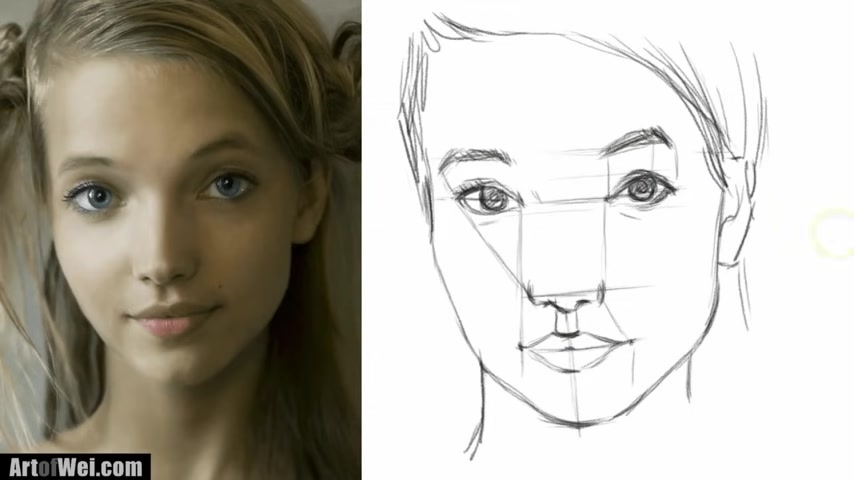
All right .
So let's check the features and see how close we got .
Make the lines a little bit darker here and let's duplicate this layer and I'll move it over and then we're going to check it .
So I'm gonna scale it up because I knew I draw a little bit bigger .
Let's scale it up and let's find some points to match up and let's do her so we could do her nose , scale it up , her nose and her eye started eye .
Ok .
It's probably be around there now we can check it .
So it looks like the error .
Let's see .
We started from the , I started from the eye here and then again , this eye was a little bit lower .
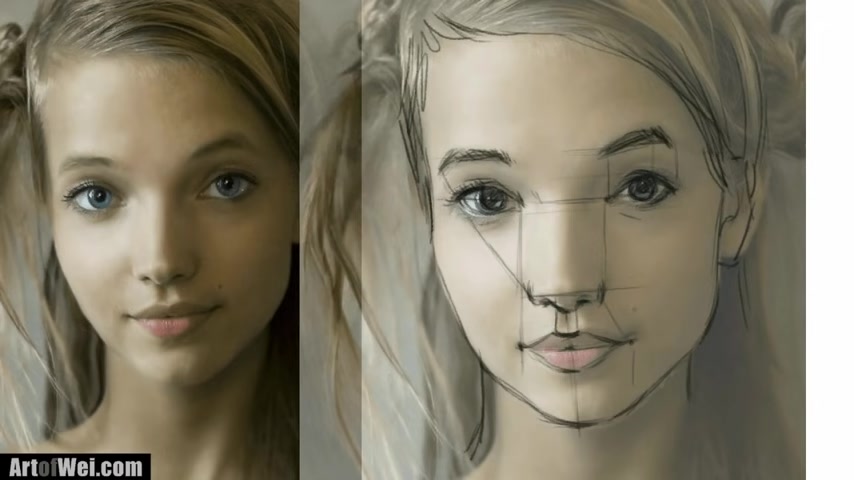
I think we , I caught that at the beginning but we just went with it .
Um And then her mouth looks like , yeah , the knees is slam up a little bit more .
I got it kind of straight .
So as you can see the corner of her mouth is a little bit off and then the chin , yeah , a little bit could be a little bit lower .
But um I mean , overall it's not bad , you know , for a first pass .
Um So if I were to finish this drawing , what I'll do is , you know , I'll , I'll correct those little errors and things like that .
But you can see just by this kind of measuring method of just seeing relationships , you can get it uh fairly close on the first path .
And the more you do it , you know , the more you're gonna be able , able to see these relationships and the more accurate , you're going to be .
So let me recap this real quick and just talk about some exercises that you can do .
So whenever you look at anything like a phase , you know , what you want to do is start measuring and get angles of stuff .
Like if I look at this phase , you know , what is the angle from , from , from the corner of the eye ?
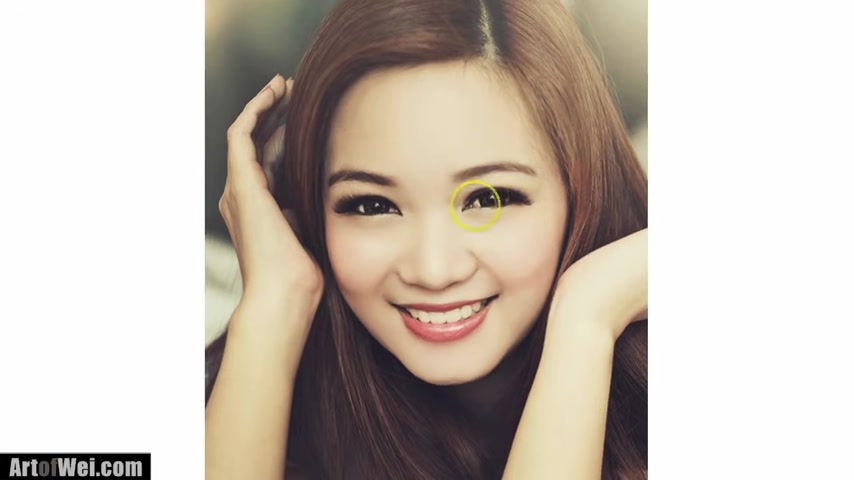
You know how like what's the slant , right ?
If I saturated now , you can easily see that it's slanting upward and you know how , how wide is this is her , is her eye and how wide is her nose ?
And you can start comparing things like , you know , I I'll say this eye is probably , you know , not as wide as her , as her nose and her eye was probably only this , this wide , right ?
And then you can , you know , in Photoshop , I guess you can , you can check it easier , things like that .
So it's just a matter of seeing relationships , you know , this thing going straight down and it's always like between vertical and uh and horizontal , you know , those are the easiest one to measure .
Uh and ver vertically works really well .
Um because , you know , it's easier to see like , you know , from the corner of her eyes , to her , to her nose , you know , corner of her mouth , how far does it go up , you know , things like that , like even like here her brow where does it , where does it go down or here ?
And from here to here , what's the angle ?
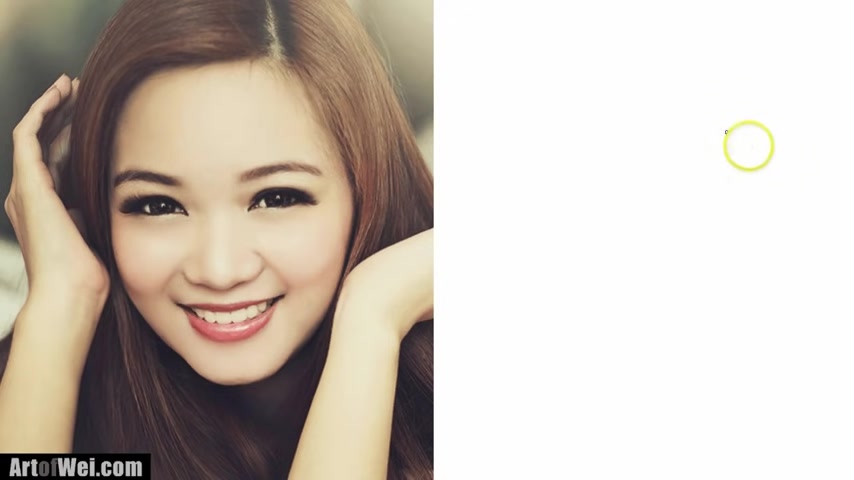
So those are the things that , you know , you want to look at when , when , when you're sketching and drawing .
And so let me show you some exercises that you can do to improve your artistic eye .
OK .
So to practice on seeing relationships , um There's a lot of easy things you can do .
Um let's just say , you know , you draw a line like this , right ?
And then somewhere else , what you do is just try to draw that line again , but with the same width , so see if you can get it close to what you have drawn initially .
So if I draw something like this , I think that's pretty close .
Um Now , of course , I'm working in Photoshop .
So it's easier for me to check uh if you're doing with , with pencils and stuff , you know , you can use a ruler and , and things like that .
So , so it's really fun , you know , you can just do something like that and then just somewhere else , you know , further away , try to draw the same length and you know , you can , again , you can , you can start checking and how close you get .
Another thing you can do is angles , right ?
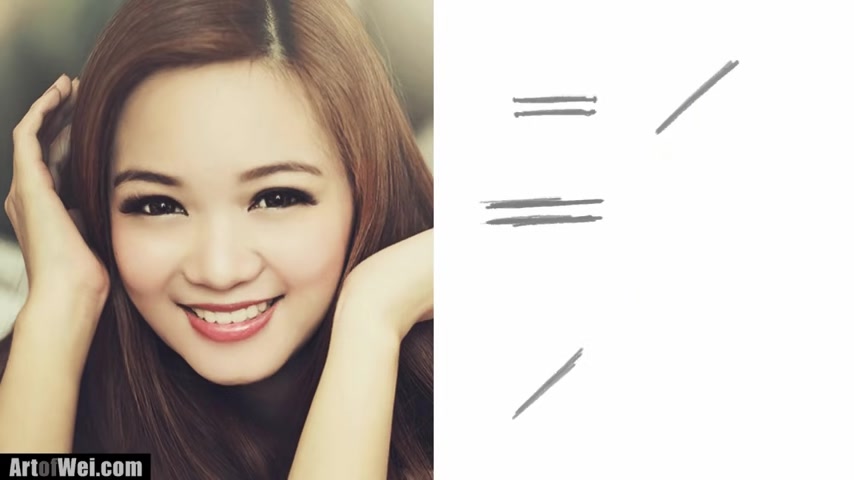
Being able to see angles , let's say I'm going to draw that or draw the same angle somewhere else .
I can do that and then I can check it right , pretty close or maybe even , you know , something crazy , maybe a line like this and try to draw the same shape somewhere else .
I gotta check it .
So it's really good exercise because you can just go like that and then draw the same lane somewhere else or do that or maybe even draw it at a different angle but try to keep the same length , maybe something like this .
That would be pretty cool .
Maybe , let's see , see if that's close .
So that's pretty close .
Um So that's , you know , just trying to uh you know , get , get used to seeing the length of things .
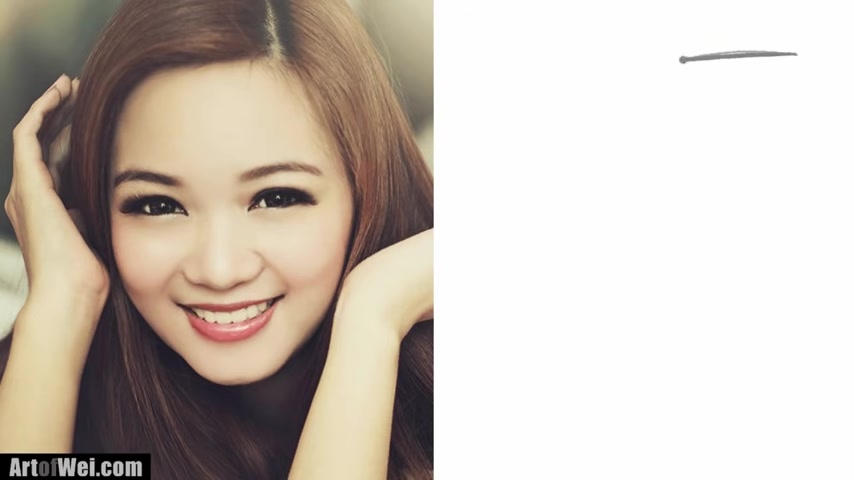
Now , let's say you're doing uh some placement , let's say I'm gonna draw a line like this and I'm gonna take this edge , I'm gonna draw something on the bottom here .
That is uh that is , you know , to the , to the left of this edge .
So if I draw a line , something like this , now this , this should be vertical , see .
So that's , that's pretty close right now .
If you draw something like this , then obviously you didn't see the , you didn't see that , that vertical um comparison .
So let's say I can do something like this .
Let's draw something to the right of it , maybe further down , maybe I'll do it from here .
OK .
And then I can check it , see how close I got .
So I'm a little bit off , right , obviously , the further down the further the distance , you know , the harder things are .
Um So that's another way of checking placement .
And here's something you can also do this , let's say you draw a circle .
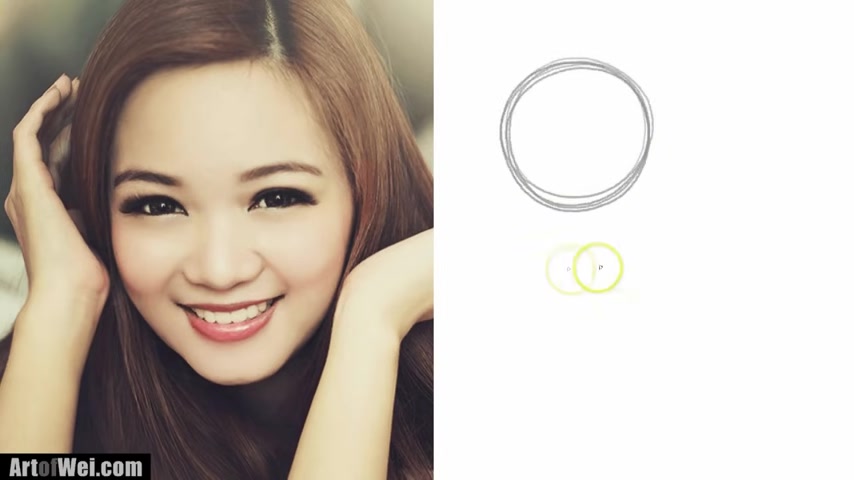
Now let's do um draw a line that represents the , the , the uh the width of the circle .
So to see that circle , I , I'm looking at that circle , I , I'm trying to vision , you know how wide that that thing is .
So I can check this .
I think my jaw is a little bit too wide .
Actually , it's pretty close .
So that's another thing you can do .
So just do a little circle and then , well , let's draw a line uh with the , the width of this , maybe at a different angle and see how close I can get to that .
Say I do that and I put it in .
So that's pretty close .
So those are exercises you can do , you know , if you're , you're drawing this and you're doing this then , you know , you probably got a long way to go .
Um But it's just a matter of training your eye and it , it's , it's pretty cool , you know , once you get it , it's just , you see things a little bit differently .
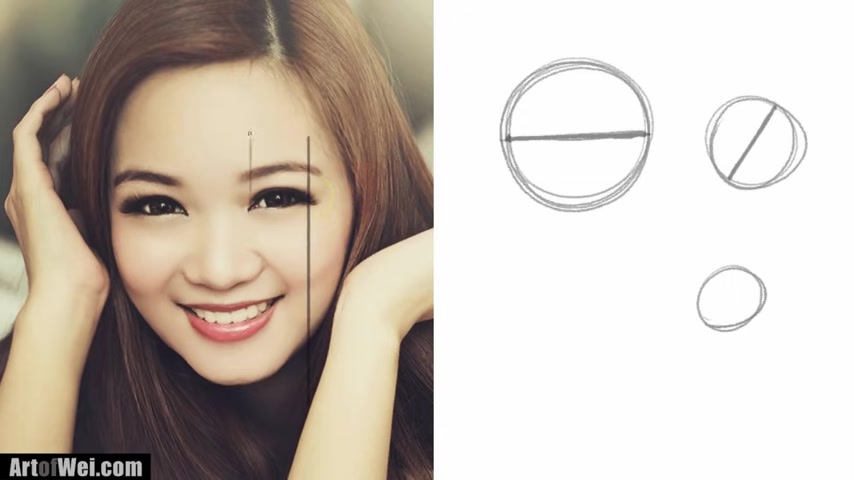
So , uh yeah , just , you know , just try this little exercise and next time , next time you see a face just , you know , start envisioning this kind of stuff over it , you know , where is it matching up ?
You know , how , what are the angles , you know , and then you gotta start seeing things and , and once you're able to see it , then you can replicate it .
All right .
So that's it for this video .
And I hope you enjoyed this and I will see you next time .
Are you looking for a way to reach a wider audience and get more views on your videos?
Our innovative video to text transcribing service can help you do just that.
We provide accurate transcriptions of your videos along with visual content that will help you attract new viewers and keep them engaged. Plus, our data analytics and ad campaign tools can help you monetize your content and maximize your revenue.
Let's partner up and take your video content to the next level!
Contact us today to learn more.